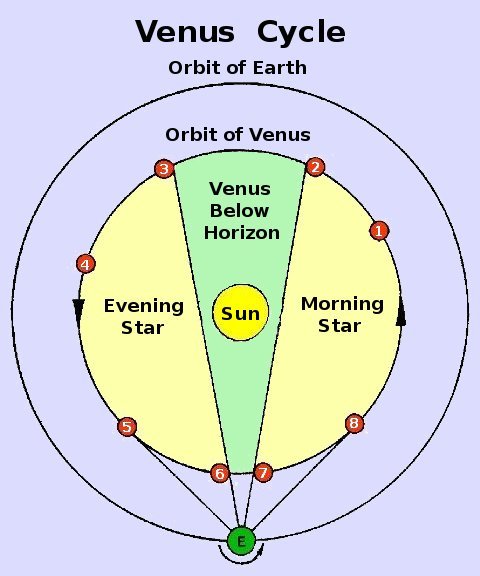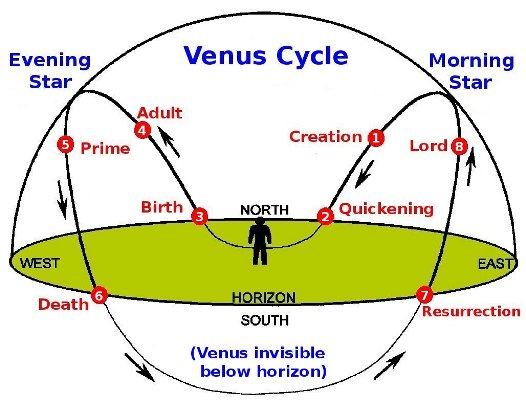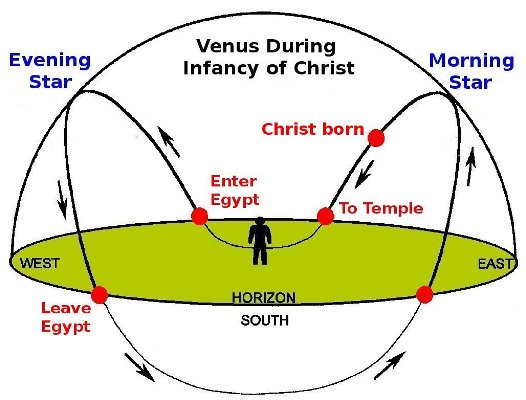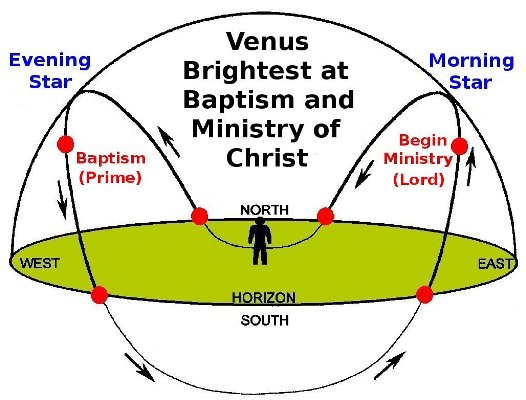
Reprinted from Meridian Magazine (10 Feb 2010).
©2010 by John P. Pratt. All rights Reserved.
| 1. The Venus Calendar |
| 2. The Infancy of Christ |
| 2.1 The Wise Men Visit |
| 2.2 The Trip to Egypt |
| 3. The Baptism and Ministry |
| 4. Conclusion |
| Notes |
Many precise dates have been proposed in my previous work for the life of our Savior, Jesus Christ. Several of these have been shown to have been holy days on several sacred calendars at once. One of the principal calendars is the Venus calendar, and indeed the Savior has identified himself with the "day star" or "bright and morning star" (2 Pet. 1:19, Rev. 22:16). This article combines the pieces which have been published previously with two new dates which have been recently discovered, to show one consistent pattern throughout the Savior's life. In particular, there are eight sacred places in the orbit of Venus, and eight different key events in the Savior's life, which occurred when His planet was at each one of those sacred places.
There has always been much confusion about the timing of the visit of the wise men and also of the Herod's murdering of the infants and the flight of Joseph, Mary and Jesus to Egypt to escape it and their subsequent return. Formerly, I had not even attempted to date those events because the chronological details included in the New Testament record were so sketchy. Then as I was attempting to write of summary of evidence for all of the dates in the life of Christ, showing how the sacred calendars of God interact, I stumbled onto the key to knowing with certainty the date of the slaughter of the infants. Matthew was right, that event had been predicted by Jeremiah and was a known milestone on the Savior's journey through mortality. And His return from Egypt was also prophesied and timed by the words of an angel. Before we can understand the evidence for these new dates, and also appreciate the Venus pattern throughout the Savior's life, we need to understand the basics of the Venus calendar.
The Venus Calendar keeps track of the position of the planet Venus in the heavens. Venus is nearer to the sun that the earth, so it can never be opposite from the sun in the sky. That means that if you see a bright star up at midnight, it is never Venus. When Venus is near the sun, it is invisible and below the horizon at night. When it is on one side of its orbit from the sun, it is the "morning star" in the eastern dawn sky and when it is on the other side it is the "evening star". It is much brighter than any star in the sky, so it is a really impressive sight. But it can never get very far from the sun.
Look at Figure 1 to understand its motion. At position (3), Venus is far from us and the dimmest that we can see it. It is moving counterclockwise in its orbit and the angle between it and the sun is increasing. Position (3) is the evening on which the planet is just barely visible in the western twilight after sunset, and then it immediately sets. It was said by the Aztecs to be "born" on that night. On the next night it moves farther from the sun and stays up longer. It begins to rise higher every night and to get brighter, even as a child grows. At a (rather arbitrary) point it is said to be an "Adult" (4) and finally it reaches "Prime" (5) where it is essentially both highest and brightest in the sky. It is highest because the angle from the sun is maximum as shown. Technically the brightest point is a few days after that because it keeps getting nearer to the sun, but one point suffices. Then it appears to swiftly plunge into the ground at point (6), where Venus dies as it sets with the sun.
 |
Note that in this figure the earth is drawn as if stationary at the bottom of the picture. The period for Venus to orbit the sun in space is only 224.7 days (the sidereal period), but when one considers its motion relative to the earth as in this figure, the period is 583.92 days (the synodic period). The length of the life of Venus (as an evening star) is about 263 days on the average.
Now look at Figure 2 and find the same eight points in that diagram. In this figure, you are located on a flat earth at the center of the figure where the little person is. The semicircle above represents the sky, as if Venus and all the stars were on a crystal hemisphere overhead. You can see the entire "life" of Venus is in the western sky as an evening star. Trace how it rises at point (3) and then it rises higher every night until it is highest and brightest at point (5) and then dies at (6) shortly thereafter.
 |
The Venus calendar tracks the average position of the planet, not the actual observable position in the heavens. That way, every Venus cycle can be calculated using the same phase lengths. The Venus Calendar is synchronized with the 13-day trecena of the Sacred Round.[1] Just like we have a 7-day week which is independent of any astronomical body, so is there also a 13-day cycle called the "trecena" that is simply a continuous count of days numbered from 1 to 13. Neither the week nor the trecena ever have any extra "leap" days added. And like the week, the trecena runs independently of any heavenly body; it is simply a continuous day count.
| Phase | Days |
|---|---|
| 1. Creation | 39 |
| 2. Quickening | 52 |
| 3. Birth | 91 |
| 4. Adult | 78 |
| 5. Prime | 91 |
| 6. Death | 13 |
| 7. Resurrection | 78 |
| 8. Lord | 143 |
| Total | 585 |
The day on the Venus calendar begins at midnight, just as on our usual Gregorian calendar. The planet Venus is visible before and after sunset, or before and after sunrise. It would not work to have a Venus day begin at either sunrise or sunset because then the Venus day would change in the midst of watching it. But the planet is never visible at midnight because it is always near the sun. All of my research is consistent with the Venus day starting at midnight.
The days are numbered by the phase. The first day of the cycle is 1 Creation, the second is 2 Creation, etc. The first day of the next phase is 1 Quickening. The last day of creation could be called 39 Creation, but instead it is called 0 Quickening. The same pattern is used all around the cycle. The last day of Quickening is 0 Birth, and Venus is born on the day 1 Birth. The first and last day of each of the eight phases is a holy day. Thus, every day "0" and "1" is a holy day, for a total of 16 holy days in the 585-day Venus Calendar cycle. So there are not too many sacred days on the Venus Calendar, and it is a rare thing to be a holy day on multiple sacred calendars simultaneously. For example, the chances of a randomly chosen independent event to have occurred on a holy day on the Venus calendar and also on one of the ten principal holy days on the Hebrew calendar is 16/584 x 10/365 = 1/1,332. That means one would have to look at about 1,300 known events to expect to find only one such coincidence from chance alone.
An important point to understand is that because the Venus calendar is locked into the trecena count, there is very little room for adjustments. In this article the point will be made that eight special events in the Savior's life coincided with Holy days on the Venus calendar. In the beginning of the Savior's life the Venus cycle is already aligned well with the trecena. That is, the actual birth of Venus occurs near a day numbered 1. Thus, the author cannot arbitrarily fit the orbit to the calendar. It fits where it fits and there are only slight variations possible and those only where the calendar needs to be adjusted.
Now we are ready to take a look at four dates during the infancy of Jesus Christ which exactly match the first four holy days on the same Venus Cycle. Two of these have been discussed in detail in earlier articles are two are new in this article.
The date of the birth of Christ has been discussed at length in my work.[3] There has been conflicting evidence of His birth date, and the majority of researchers have concluded that Christ was born in 6-4 BC. Elsewhere I have explained that such a conclusion, which is based on the works of the historian Josephus, is founded on his erroneous understanding that Herod's successors began to reign in either 4 or 3 BC. King Herod the Great reigned for 37 years beginning in 37 BC, and he died in about February, AD 1. The date proposed in my work for the birth of Christ is the evening of Wed 5 Apr 1 BC, after sunset. The date on the Hebrew calendar, where the day begins just after sunset, would correspond to Thu 6 Apr 1 BC (see D&C 20:1), which was the Hebrew holy day of Passover.
The day 5 Apr 1 BC was the day "1" on the trecena.[4] When one looks at the Venus cycle, it was clearly the day 1 Creation, the beginning day of the cycle. There is essentially no latitude in this choice, because the actual mean position is very close to that day. Moving it 13 days sooner or later would cause too much of a discrepancy. Once this day is selected as "1 Creation" on the Venus cycle, all of the days for that cycle are determined by the phase lengths listed in Table 1 for at least a decade. There is no more allowance to adjust them at all.
 |
Now we come to two new dates discovered recently. Sometime after the baby's birth, the family was visited by the wise men. After they left without telling Herod of the child's location, Herod ordered the slaughter of the infants. On the night previous, an angel warned Joseph to take Mary and the infant and flee to Egypt. Then after Herod had died, the same angel advised them that it was time to take the child back (Mat. 2:13-20).
Joseph and Mary lived in Nazareth. They only came to Bethlehem for the census and to celebrate Passover. They would have stayed until at least the Feast of Firstfruits seven weeks later, which Joseph was also required to attend. Then they would soon have been on their way back to Nazareth. The wise men probably came at about the Feast of Firstfruits, and it now appears to me that they probably came on that very day, Sat 27 May 1 BC after sunset. They could easily have made the trip from the east in seven weeks.
The reason the date may well be the precise date of the wise men's visit is twofold. First, it fell on the Feast of Firstfruits, and Jesus was the blessed firstfruits of Mary. It was also Firstfruits on the Enoch Calendar. Secondly, the day fell on 1 Serpent on the Sacred Round. The symbol Serpent represents mortality, and one species was a special symbol of Christ.[7] Thus the day "1 Serpent" meaning "beginning of mortality for the Feathered Serpent" was like another birth day for Jesus. That day, 1 Serpent was also the birth day of Isaac. Even though neither of these facts tie the date directly to the wise men, it was rather like a birthday, and the wise men were coming to celebrate His birth.
King Herod died about Feb, AD 1. One would think that it would probably be safe for the family to return shortly thereafter. When in fact did the family return? There are three clues that the date was significant. First, Joseph was commanded to stay in Egypt until the same angel again visited him and told him to return. Secondly, the angel did indeed return and selected the date to commence the return trip: "Arise, and take the young child and his mother, and go into the land of Israel: for they are dead which sought the young child's life" (Mat. 2:20). Thirdly, Matthew testifies that the event had been foretold by the prophet Hosea centuries before: "Out of Egypt have I called my son" (Mat. 2:15; Hosea 11:1). So we have several witnesses that the date of the return from Egypt, determined by an angel, may also have been significant on a sacred calendar.
The day Thu 22 Mar AD 1 was 1 Death on the Venus calendar and coincided again with the Hebrew holy day of Consecration, when the Passover lamb is chosen. The day 1 Death occurred on the day 1 Dragon of the Sacred Round. The fact that it is the same as the day 1 Birth is not surprising. The life of Venus always begins and ends on the same day on the Sacred Round because the interval is 260 days, exactly the length of the sacred round cycle. But this time it makes the symbolic connection between King Herod (the Dragon in this case) and 1 Death. In other words, 1 Dragon 1 Death symbolized the death of the dragon, so the consecrated infant could return in safety. Figure 3 illustrates these four proposed dates during the infancy of Jesus, which all occurred on the same Venus cycle. Again we have several witnesses that this date is correct. Thus it is proposed that the slaughter occurred only three months after the birth of Jesus, and that the family stayed nearly nine months in Egypt.
Table 2 summarizes all of the dates proposed so far in my work for the infancy of Jesus Christ. The references for each date can be found on my website in a table of all Religious Chronology dates published so far from my research.[8]
| Event | Gregorian | Hebrew Calendar | S. Round | Venus | Other |
|---|---|---|---|---|---|
| Annunciation | Sun 13 Jun 2 BC | Firstfruits | — | — | 1 Jeshua (P) & Firstfruits (J) |
| Conception | Tue 15 Jun 2 BC* | 15 Sivan | — | — | — |
| Baptist born | Wed 6 Oct 2 BC* | Atonement | 1 Monkey | — | — |
| Christ born | Wed 5 Apr 1 BC* | First Day Passover | 1 Reed | 1 Creation | 1 Creation (M) |
| Circumcision | Wed 12 Apr 1 BC | Last Day Passover | — | — | Feast of Esther (EF) |
| To Temple | Sun 14 May 1 BC | — | 1 Grass | 1 Quick | Easter (EF, JF), 1 Birth (M), 1 Jeshua (P) |
| Wise Men | Sat 27 May 1 BC* | Firstfruits | 1 Serpent | — | Firstfruits (E) |
| To Egypt | Wed 5 Jul 1 BC* | Mourning | 1 Dragon | 1 Birth | 1 Resurrection (M) |
| Herod's Death | about Feb AD 1 | — | — | — | — |
| From Egypt | Thu 22 Mar AD 1 | Consecration | 1 Dragon | 1 Death | 1 Creation (M) |
The dates of the Baptism of the Savior (Sat 6 Oct AD 29) and of the beginning of His public ministry (Sat 6 Apr AD 30) have been discussed in detail in former articles.[9] Both events occurred on holy days on the Hebrew Calendar, the baptism being on the Day of Atonement in the fall, and the ministry beginning on Passover in the spring (John 2:23). Now let us look at the symmetry of these two dates in more detail.
First, note that the two dates occur exactly six months apart. On the Enoch solar calendar, the Baptism was on 14 Autumn and the Ministry began on 14 Spring, exactly 182 days apart (half of 365). Those two days are the Feast of Tabernacles and the Feast of Passover on the Enoch calendar, as discussed in detail elsewhere.[10] Both days were also Saturday, the holy day of the week at that time, so they are aligned with the weekly cycle. Both days occurred on day 13 of a trecena, so they were holy days on the Sacred Round. And on the Enoch Fixed calendar (different from the Enoch solar), the two days were also Tabernacles and Passover. So these two dates are amazing before we even consider the Venus calendar.
 |
There are two remaining dates to complete the set of eight. The first is the day of the Transfiguration, Sat 2 Oct AD 32. It occurred on the Day of Atonement, which was the Feast of Tabernacles on the Enoch calendar, when the apostles suggested making tabernacles for Elijah and Moses (Mat 17:4). It also occurred on the Great Day on the Jubilee calendar, as did the Baptism.[12] That date was 0 Adult on the Venus calendar, marking another major milestone on a holy day on that calendar.
The final date of the eight was that of the Resurrection, the date which led to the discovery of the Venus calendar. That occurred before dawn on Sun 3 Apr AD 33, being the first date published in my research, and the best attested precise date in the New Testament.[13] It fell exactly on the day 1 Resurrection on the Venus calendar. Of the eight, that is the only one where the event matches perfectly with the Venus day. That is, the Savior resurrected on the one day in 585 representing the resurrection of Venus. That alone is a rare event. Easter Sunday morning only occurs on 1 Resurrection about once in 584 years on the average. If one then multiplies that by the odds of seven other events from the Savior's life all occurring on the other seven holy places in the Venus cycle, the odds against it happening by chance are astronomical.
Table 3 summarizes all eight events, one for each of the holy points in the Venus cycle. Note that all but one were also on holy days on the Hebrew calendar. The dates on the Sacred Round are also listed because the figures are so appropriate. The Savior was baptized on the day Water, and He shone like the sun at His transfiguration on the day Light. He was born on the day Reed (resurrection) and resurrected on the day Temple (birth), so those two are interchanged. Herod entered the infant's life on Dragon (symbol of Satan) and his influence ended on that day. Thus we have multiple witnesses of the correctness of these proposed dates. The heavens truly testify of Christ (Moses 6:63).
| Event | Date | Venus Day | Hebrew | S. Round |
|---|---|---|---|---|
| Christ born | Wed 5 Apr 1 BC* | 1 Creation | Passover | 1 Reed |
| To Temple | Sun 14 May 1 BC | 1 Quickening | — | 1 Grass |
| To Egypt | Wed 5 Jul 1 BC* | 1 Birth | Mourning | 1 Dragon |
| From Egypt | Thu 22 Mar AD 1 | 1 Death | Consecration | 1 Dragon |
| Baptism | Sat 6 Oct AD 29 | 0 Prime | Atonement | 13 Water |
| Public Ministry | Sat 6 Apr AD 30 | 0 Lord | Passover | 13 Monkey |
| Transfiguration | Sat 2 Oct AD 32 | 0 Adult | Atonement | 13 Light |
| Resurrection | Sun 3 Apr AD 33 | 1 Resurrection | Easter | 13 Temple |
This article proposes that the Venus cycle is so closely related to the Savior's life that all eight holy day pairs on the Venus cycle are associated with events of His life which occurred on those days. Two new dates proposed in this article are for the flight to Egypt at the slaughter of the infants, and of the return from Egypt. The events were associated with the "birth" and "death" of Venus as the beginning and end dates of that prophesied sojourn. Multiple witnesses from other calendars testify of the correctness of these dates, such as being the appropriate Hebrew calendar day for Rachel to weep for her slain sons.
It is far beyond the possibilities of chance coincidence for so many dates to align on so many sacred calendars. These multiple witnesses provide strong testimony of the hand of God testifying that Jesus was indeed the Son of God, and that Venus was truly His special symbol.